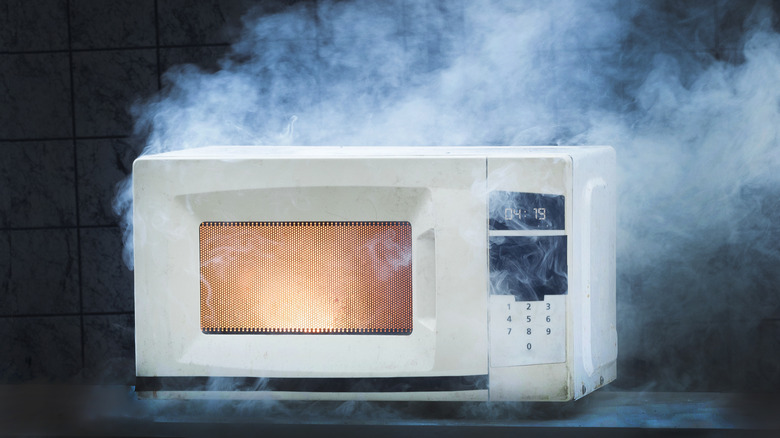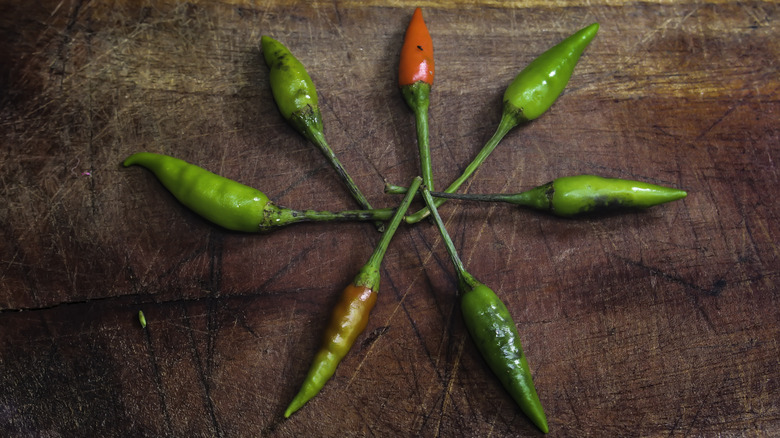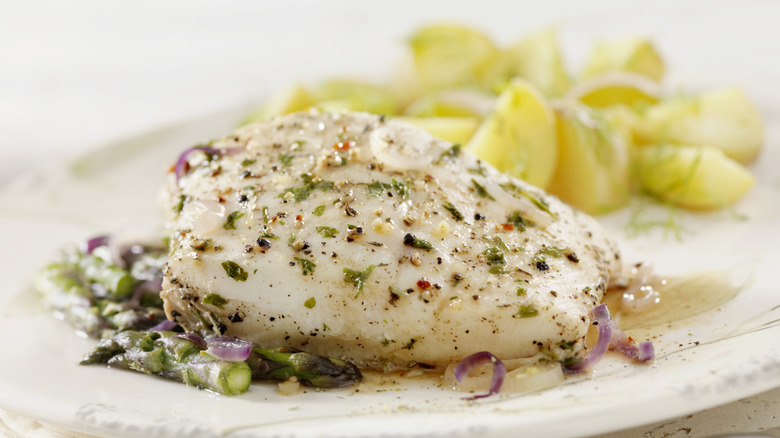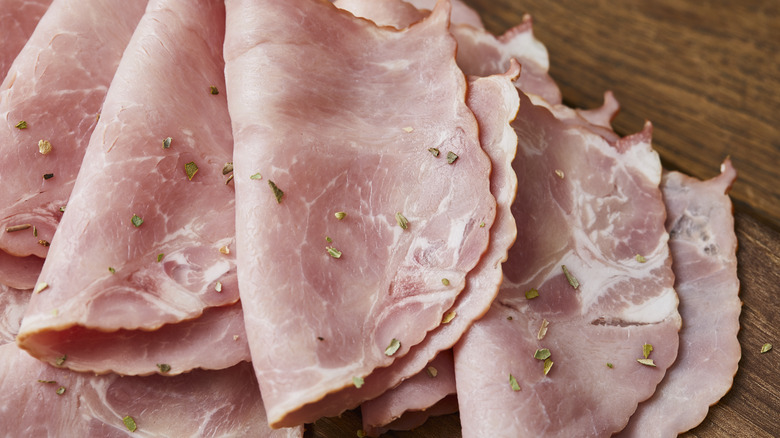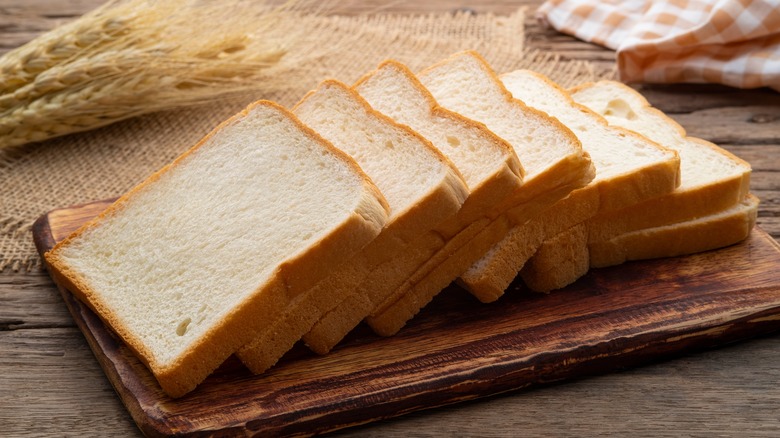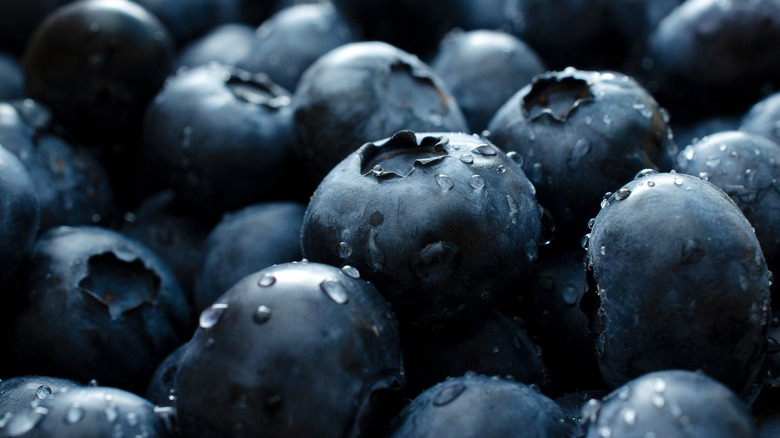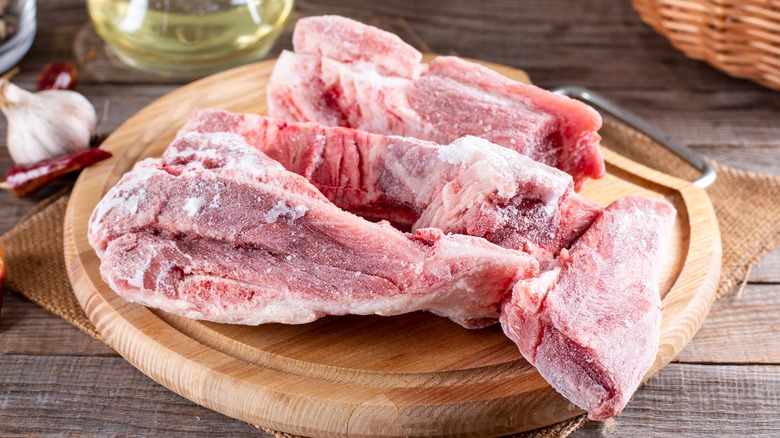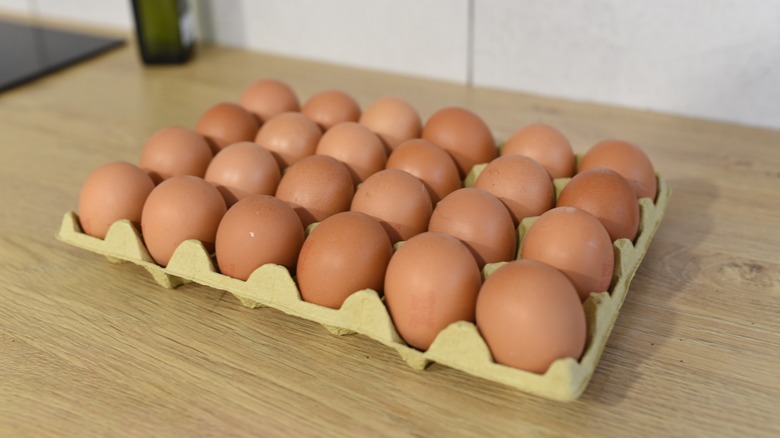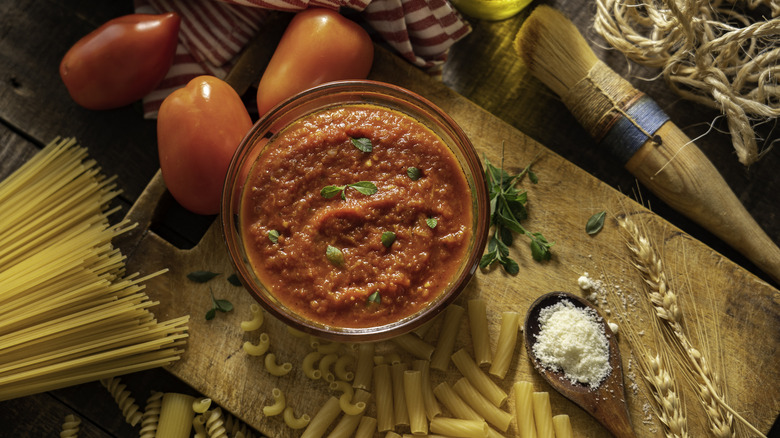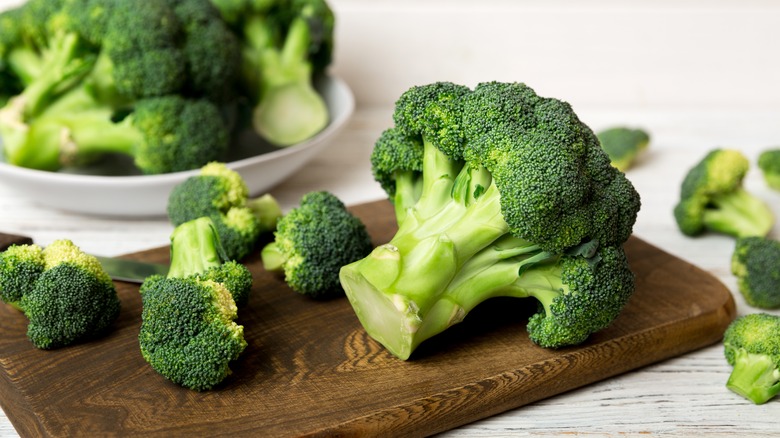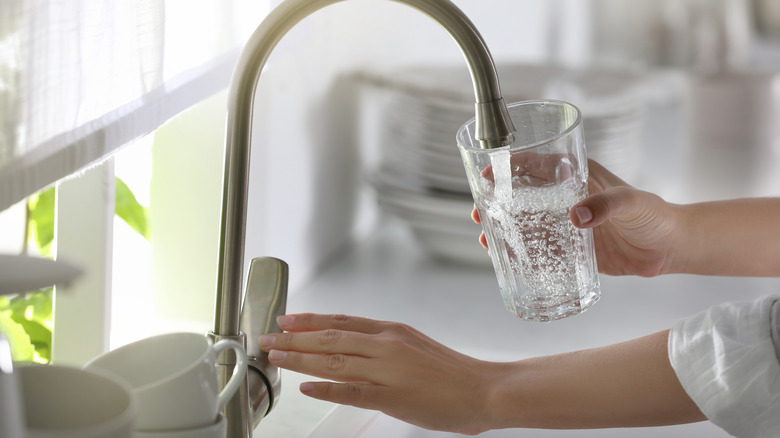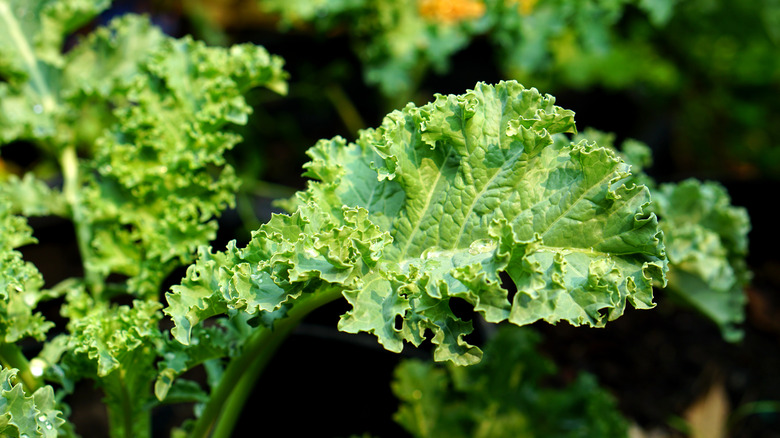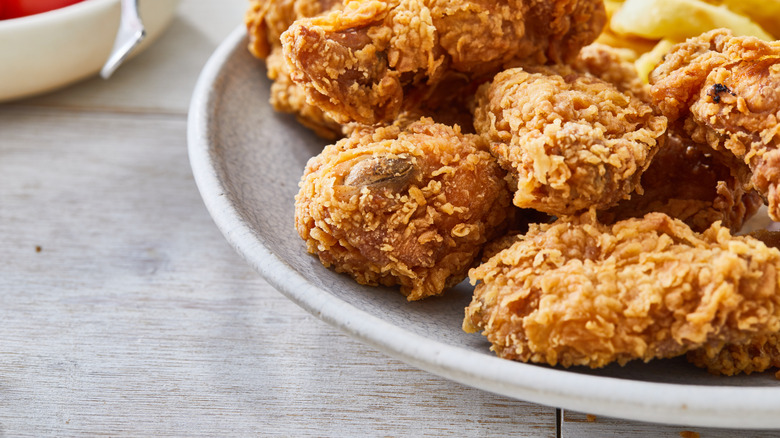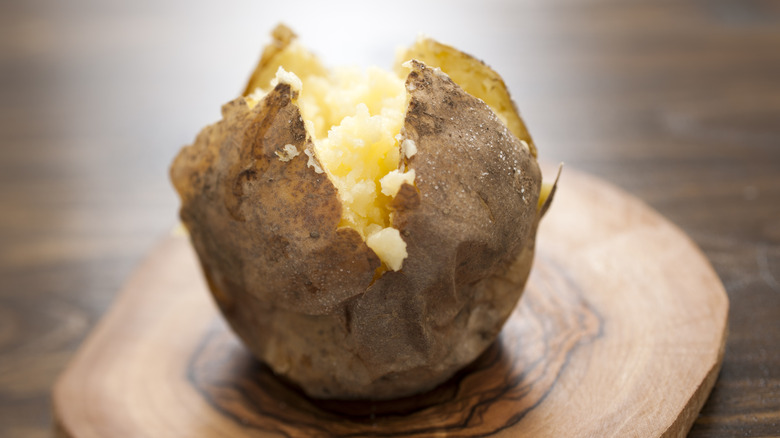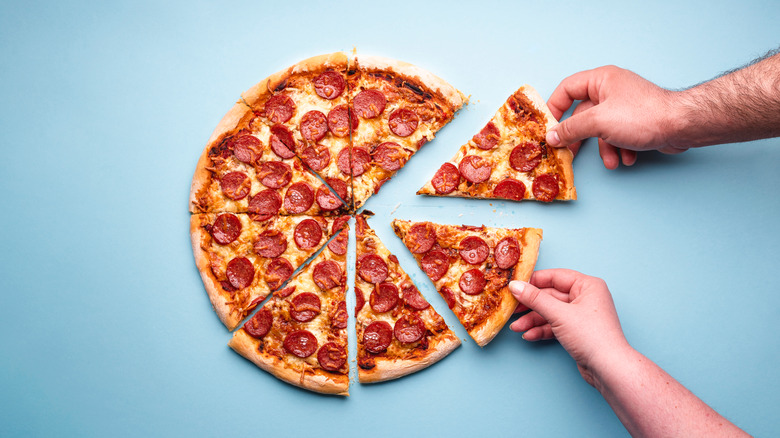15 Things You Should Never Put In The Microwave
The microwave is one of the most popular kitchen appliances out there, and in the United States, it's also the most owned. Approximately 82% of households owned a microwave in 2023, according to Statista, a number that indicated that more people had one of these machines than a cooker or oven, around 72%, and, incredibly, a fridge, at 81%. And there's still an appetite for these machines — the microwave market in the U.S. is set to rise by 5.5% each year until 2028 when over 17 million appliances are expected to sell, as shown by Statista.
So why is the microwave so enduringly popular? Because you can use it for pretty much anything. Whether you're cooking crispy bacon or reheating ramen, the microwave can do it all much quicker than if you were to perform the same action in a pan or the oven. When you flick on your microwave, the electromagnetic waves permeate the outer layers of your food almost instantly, warming up its molecules, with the heat then moving quickly to its center. But this method doesn't result in seamless results for every type of food. And in some situations, it can leave whatever you take out of the microwave in a worse state than when it was put in.
Chili peppers
Microwaving chili peppers isn't the most common method of cooking them. But if you're trying to soften them before placing them in your food or looking to make roasted chili peppers without the use of your oven, then you may be tempted to pop them in. Microwaving chili peppers, however, can be risky. When hot chilis are heated by electromagnetic waves, their capsaicin, the compound that makes them spicy, is dispersed into the air and then into your kitchen once you open the microwave door. It's worth remembering that capsaicin is an irritant and is one of the key components of pepper spray. As well as causing your mouth to burn, it can inflame and irritate your eyes, skin, and lungs, according to the National Pesticide Information Center.
Luckily, cooking chili peppers in different ways doesn't seem to have as extreme of an effect on their capsaicin content. So, we'd recommend grilling or roasting them instead. This will give you that chargrilled effect that makes chili peppers so delicious while also softening their flesh. Cooking chili peppers like this, interestingly, may also make them less spicy, dampening the impact of the capsaicin and potentially making super-hot chilies easier to stomach.
Fish
While the quick reheating action of the microwave might work for a lot of foods, it's likely not going to be great for fish. Fish flesh is especially delicate and, somewhat strangely for an animal that spends its life in the sea, prone to drying out. When it's reheated in a microwave, though, the outer layers of the fish heat up quickly, while the inside takes longer. This can mean that by the time your fillet is heated through, the outside has already lost its moisture and become dry.
Placing fish in the microwave is also a surefire way to make yourself some enemies in the office. Rather than face being shunned for your stinky lunch, keep your food at home and reheat it in the oven. Using a low-set oven allows the heat to gently pass through your fish, which helps it better retain its moisture. In addition, make sure you're wrapping any fish fillets you're warming up in tin foil. Not only will this better insulate the fish as it warms up, preventing heat loss, but it will also trap any moisture that tries to escape. Avoid doing this if you're reheating a breaded fish fillet, though, as this will just make it go soggy.
Deli meat
It's no secret that deli meats are highly processed, with the procedure they go through to be preserved or add flavor also potentially causing them to have "cancer-causing substances," according to MDAnderson. But one lesser-known effect that deli meat and other processed meats can have is if they're microwaved.
A study published in the journal Lipids in Health and Disease found that when processed meat products like deli meat, bacon, and sausages were microwaved, they produced a higher amount of cholesterol oxidation products, or COPs. This tended to be even worse if the products were refrigerated and then reheated or were already cooked and reheated. And this is pretty bad news for your health. Cholesterol oxidation products can have a huge impact on your risk of developing multiple serious chronic diseases, like diabetes, kidney failure, and heart disease, according to NutritionFacts.
Importantly, cholesterol oxidation products can also be produced via other cooking methods, with oven grilling tending to be as bad as microwaving. Pan-roasting processed meat, however, seemed to have a less intense production of COPs. Remember, though, that eating processed meat regularly can cause an increase in the risk of diseases like cancer and cardiovascular disease, regardless of whether it's microwaved or not, according to Harvard Health Publishing – so there's probably never been a better time to switch to fresh-meat products.
Bread
Anyone who's ever put bread in the microwave will know how quickly you have to act. If you zap it for a few seconds, it's a great way to soften it up — but any longer than that, and you could have something inedible on your hands. When you put bread in a microwave, the electromagnetic waves quickly go to work on the water and starch molecules, causing the latter to gelatinize and the former to steam, releasing heat. This has a twofold effect: At first, it makes the bread softer, but after a certain amount of time, the bread will lose its moisture, and the starch will harden, making it hard, chewy, and difficult to eat.
What bread absolutely won't do in the microwave, too, is develop any brown color or turn into toast. This only happens with the direct heat that a toaster supplies the outside of the bread. If you're trying to reheat bread, the best thing to do is to place it in the oven. Pop it inside some aluminum foil, sprinkling a little bit of water on it first to help create steam and reintroduce moisture. Then, put the package in a preheated oven for about 10 minutes or until the bread is piping hot and soft.
Blueberries
It might seem like microwaving blueberries is a good idea if you're making a quick blueberry syrup or pie filling. But bear in mind that when you do that, you may lose a lot of what makes them so special in the first place. A study published in the aptly-named Journal of Berry Research examined the effects of cooking blueberries after they've been harvested and what various handling methods do to their ultra-nutritious quality. And microwaving turned out to be a bad move for the berries. "What we can say from this study is that cooking and heating, especially longer microwaving, does decrease the amount of beneficial compounds in the berries," states Michael Grusak, per NC State University.
It was found that microwaving the berries broke down their healthy pigments and antioxidants more than other methods, although baking and boiling them also had a negative effect. Researchers did point out that cooking them didn't entirely strip them of their goodness, with health-beneficial components still present after they've been heated. But if you want your blueberries to be as nutritious as they can be, it's probably a good idea not to cook them at all or to skip the microwave when doing so.
Frozen meat
Defrosting meat can take a long time. To do so safely, it's recommended that you leave your meat in the fridge to control its temperature rise, and for large items, it can take 24 hours or more until they're completely thawed. So it's natural that some people would feel inclined to make use of the defrost function on their microwave with their meat.
Doing so, though, can cause you problems. Microwaves work by heating the outside of the food first, and this happens even when you're using a defrost setting. There's no difference in function — the power of the microwave is simply reduced to around 30%. What this means, though, is that if you're trying to defrost something, the outside of the food will melt first and then cook first. For dense, solidly frozen items like meat, it can take a while for the heat to reach the middle; by that time, the outside of the meat may have already started to cook.
This may not be such an issue if you're planning on cooking it immediately, but if you leave it, the chances of bacteria growing in the warmer sections are higher. But we're more concerned about ending up with a chicken breast or pork chop that's already semi-cooked and potentially having to throw that meat away.
Eggs
Eggs are one of those foods that it seems like you can cook whichever way you like. From boiling, steaming, frying, scrambling, and baking, eggs fare well under pretty much any heat delivery method. But one thing they won't love is being microwaved. While you might think you can make a boiled egg in the microwave, instead, the microwaves will just heat up the water inside the shell too quickly. When this happens, the egg will simply explode, with the shell and egg parts flying everywhere inside of your microwave.
Trying to microwave cracked eggs can have a similar effect, with the water molecules in the yolk heating up too quickly and the steam having nowhere to escape. If your egg is already cooked, it can still be risky to microwave it, with hard-boiled eggs having a tendency to explode.
Importantly, it is possible to microwave eggs in some forms, particularly if you're making scrambled eggs. But you might find it easier to just put them on the stove and cook them in the traditional way.
Pasta sauce
Pasta sauce can look pretty innocent, but in the microwave, it becomes a completely different beast. This foodstuff can quickly turn into a volcano in your microwave, causing an explosion when heated. The problem with pasta sauce is that it has a somewhat uneven composition, with dense pieces of tomato surrounded by much thinner water molecules. When it's placed in the microwave, the water molecules heat much faster than the tomato pieces. As they do, they create steam, and because that steam can't get past the tomato chunks, instead it forces them out via an eruption.
This can manifest pretty violently, and even when it doesn't, that pasta sauce can still splatter the inside of your microwave with loads of tiny red dots. Instead of using a microwave, the best way to heat up pasta sauce is by doing so in a pot on your stove. While this can take slightly longer, the gentle, consistent heat of the stove will heat the full mixture slowly, ensuring that there are no out-of-the-blue explosions. If you must heat your pasta sauce in the microwave, though, pause to stir it every 10 seconds or so and keep the container you're heating it in loosely covered. Make sure you use a microwave-safe container to avoid any shattering or burnt fingers.
Grapes
Cooking grapes can soften them considerably and turn them from plump and snappy to soft and gooey. But placing them in the microwave to achieve this is a risky game. In fact, placing grapes in the microwave can cause them to quite literally set on fire when they're placed right next to each other. This can occur whether they're halved or microwaved whole.
So, why does this happen? A study published in the Proceedings of the National Academy of Science figured it out. According to researchers, the buildup of electromagnetic energy that occurs when the microwave is switched on isn't contained in the singular grape but rather hops with lightning speed to the other grapes and back again. This creates an intense electromagnetic field, which heats the surrounding molecules so quickly that they burst into flames.
Interestingly, this doesn't just happen with grapes but also with any other small, round fruits or objects, like cherry tomatoes. While this might sound like a fun science experiment to try at home, bear in mind that doing so can quickly damage your microwave and could present a hazard. If you're looking to cook your grapes, you're far better off roasting them, where there's far less risk of grape-related infernos.
Broccoli
While you can eat broccoli raw, the vegetable can be a little tough for some folks, which is why it's typically cooked. But microwaving it really isn't the best way to go if you want to keep the vegetable healthy. According to a study published in the Journal of Zheijiang University, microwaving broccoli can have a significant impact on some of its healthiest parts.
Microwaving the vegetable resulted in a notable reduction in its vitamin C and chlorophyll levels. These chlorophylls in broccoli may give it its lustrous green color, but they also infuse it with a host of health-beneficial properties and have high levels of antioxidants, which could potentially have an anti-cancer effect, according to PubMed.
Importantly, other cooking methods, like boiling, had a similar effect in terms of reducing the broccoli's healthy qualities. A combo of stir-frying and boiling also seemed to bring down the nutrition levels in the vegetable. It's best to avoid the microwave entirely with your broccoli and to steam your florets instead. As the researchers of the Journal of Zheijiang University study found, this resulted in the lowest loss of chlorophyll and vitamin C, as well as other nutritional benefits.
Water
As one of the most fundamental compounds to our very existence, it seems strange to need to avoid putting water in the microwave. After all, water is present in varying quantities in pretty much every food we eat, so how risky can it be?
As it turns out, very risky. When a cup or mug of water is placed in the microwave, it's highly prone to superheating, according to UNSW, which is when it's heated to above its boiling point without actually appearing like it's boiling. This can occur in a microwave specifically because the electromagnetic power used is able to directly permeate the water, unlike in a kettle or on a stove, where the water is heated in part by the surrounding container. This also means that air isn't getting inside the water, which allows it to stay in this superheated yet contained state.
However, things all go wrong when that water is disrupted. If an object is placed in the water, it can violently explode as the water quickly comes up to boiling point. This can be both surprising and hazardous, resulting in burns if you're not extremely careful. While there are precautions you can take to stop a superheated container of water from exploding, like tapping the container with a long spoon or heating it in short bursts, we'd recommend avoiding doing it entirely.
Kale
Kale chips continue to be all the rage, and one common method of making them is to place them in the microwave. But those who do so should be warned that you run the risk of damaging your appliance. "Plants get iron and metallic micronutrients, like copper and potassium, from the soil. They take it up through their roots," explains the University of California's plant physiologist Milt McGiffen, per NPR. Kale is especially abundant in minerals, specifically iron, and on occasion, it can take on extra minerals in order to stockpile it for longer seasons.
Placing anything metal, or that has a high metallic content, in the microwave can be dangerous — and doing so with iron-rich kale can cause it to spark and set fire. This is exacerbated by the crinkled shape of kale, the nooks and crannies of which make it more prone to setting alight. While this might be exciting, it can also result in you rendering your microwave inoperable and having to shell out hundreds of dollars for a new machine. It's better to avoid this entirely and make your kale chips in the oven.
Fried chicken
Day-old fried chicken can be just as good as when you bought it, but as most people know, it tastes worse when cold. The once-crispy coating can congeal into a pasty, dense mush, and the chicken can become firm and tough. So heating it up is a must — but just not in the microwave.
Reheating fried chicken, or anything that's been fried, in the microwave, can make it even mushier than it was before. This is because a microwave works by penetrating and heating up individual molecules, most notably water ones. And those water molecules exist inside the fried coating, too, so when it's heated, it just becomes soggy. This can be made even worse by the molecules heating in the chicken flesh, making steam, which then makes the coating even wetter.
Instead of ruining your chicken like this, it's far better to place it in the oven. The dry heat of an oven will help to crisp up the outside while simultaneously warming the chicken through to its deepest parts. For maximum heating power, make sure you're using a wire rack when you heat your fried items so that the heat can get all around them.
Potatoes
Potatoes can be slightly tricky to heat in the microwave and should be treated with caution — for a few reasons. The first issue with potatoes in the microwave stems from the vegetable's high water content, especially when raw. When this water is heated, it turns into steam and needs an outlet to escape. And as potatoes are covered in skin, this steam can get trapped, resulting in the vegetable exploding.
Additionally, microwaving potatoes can be tricky from a food safety perspective. Potatoes are especially prone to developing the bacteria clostridium botulinum. This bacteria produces a toxin called botulism, which can cause incredibly serious symptoms like muscle paralysis and may even be fatal, according to the CDC. Unfortunately, heating up your potato in the microwave may not be enough to kill the spores that cause botulism, which need high, sustained heat to be properly eliminated.
As such, it's important to only reheat potatoes in the microwave, or reheat them at all, if it's safe to do so. Potatoes should never be left at room temperature for more than a few hours after being cooked, and baked potatoes should never be wrapped in tin foil to store them, as this can increase the likelihood of botulism-causing bacteria developing.
Pizza
Day-old cold pizza is one of life's great pleasures, but some people prefer to only enjoy their pie when it's warmed up. But doing so in the microwave may make you regret your choices. A good pizza is a mishmash of contrasts, with the soft, unctuous cheese being balanced by a super-crispy crust and firm base. However, when heating slices in the microwave, all of the ingredients warm up in the same manner, by the water molecules in each part of the food being heated, and this leaves everything soggy.
Luckily, there are a few ways to reheat pizza that won't involve you having to scrape it off your plate. A cast-iron skillet might be the easiest and quickest way. The skillet applies direct heat to the bottom of the slice, helping it to firm and crisp up. Placing a lid over the pan can also trap the heat, warming up the top of the pizza slice. You can also place old pizza in the oven to warm it up. Put your slices on a sheet pan, and then place them in the oven for 10-15 minutes until the bottom is firm and the top is bubbling.
